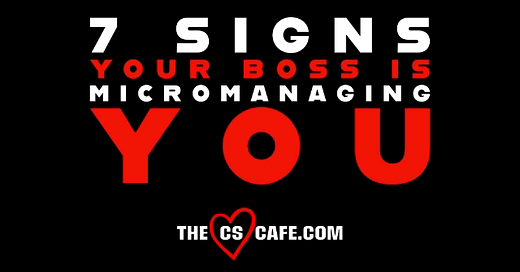Micromanagement in the workplace can significantly impact employee morale and productivity.
Recognizing signs of micromanagement is key to addressing this issue effectively and improving workplace dynamics.
Here are 7 indicators that your boss may be micromanaging you, along with actionable steps to combat this toxic management style.
7 Signs of Micromanagement:
Approval-Seeking Behavior
Constantly seeking approval for tasks can indicate micromanagement.
Combat this by setting clear expectations and boundaries to demonstrate your competence.
Constant Updates
If your manager demands frequent progress updates, it may signal micromanagement tendencies.
Maintain open communication channels to manage expectations and provide regular updates.
Trust Issues
Micromanagers often lack trust in their team, which leads to excessive control.
Build trust through consistent high-quality work, proactive communication, and demonstrate reliability.
Autonomy Restrictions
Feeling restricted in decision-making and ownership is a common trait of micromanaged environments.
Assert your capabilities, seek opportunities for autonomy, and showcase your ability to handle responsibilities independently.
Over-Communication
Excessive emails and information overload can be signs of micromanagement.
Ffocus on key updates, and set clear communication protocols.
Delegation Challenges
Difficulty delegating tasks and controlling work details are red flags for micromanagement.
Offer solutions, demonstrate your capacity to manage tasks effectively, and communicate proactively with your manager.
High Turnover Rates
A high turnover of employees can indicate negative impacts on team morale due to micromanagement.
Seek feedback, address concerns openly, and work towards building a supportive and collaborative work environment.
Strategies to Address Micromanagement:
Open Dialogue
Initiate honest conversations with your manager about how their management style affects your work and the team dynamics.
Outcome Focus
Emphasize results over activities.
Showcase your value and contributions effectively.
Proactive Communication
Keep your manager informed regularly. It will help you manage expectations and build a transparent working relationship.
Assertiveness
Demonstrate your capabilities and independence to show that you can perform effectively without constant supervision.
Documentation
Establish clear boundaries in writing to avoid misunderstandings and make sure that expectations are met consistently.
Here’s how Steve Jobs describes the best way to manage people:
Ever found yourself with a terrible boss?
Leave a comment and share your experiences dealing with micromanagement.
-Hakan.







